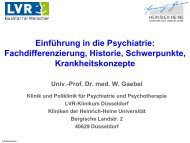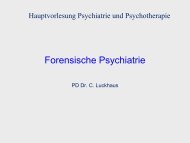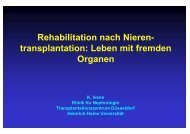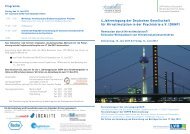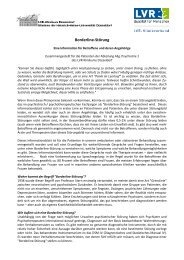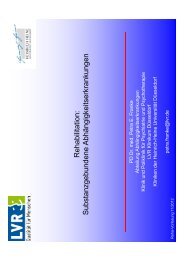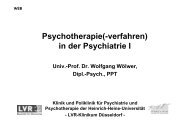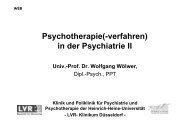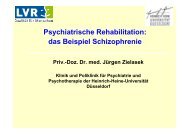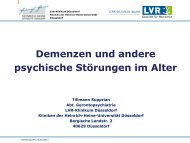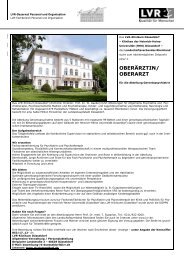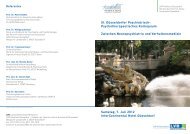LVR-Klinikum Düsseldorf Hospital of the Heinrich-Heine University ...
LVR-Klinikum Düsseldorf Hospital of the Heinrich-Heine University ...
LVR-Klinikum Düsseldorf Hospital of the Heinrich-Heine University ...
You also want an ePaper? Increase the reach of your titles
YUMPU automatically turns print PDFs into web optimized ePapers that Google loves.
cells, <strong>the</strong> cultivation <strong>of</strong> which was an important component<br />
<strong>of</strong> <strong>the</strong> experimental investigations, <strong>the</strong> disorder-dependent<br />
dysregulation <strong>of</strong> <strong>the</strong> cytosolic glucocorticoid receptor in<br />
affective disorders, <strong>the</strong> intracellular transport <strong>of</strong> clozapine<br />
via <strong>the</strong> vesicular monoamine transporters and additionally<br />
apoptotic mechanisms <strong>of</strong> neutrophil granulocytes involved in<br />
clozapine-induced agranulocytosis could be characterised in<br />
more detail. In addition to <strong>the</strong> investigations in neuronal and<br />
glial tumour cells, <strong>the</strong> laboratory has started to isolate and<br />
cultivate native neurones, astrocytes and stem cells from<br />
<strong>the</strong> CNS <strong>of</strong> mice. The aim <strong>of</strong> <strong>the</strong>se experiments is, amongst<br />
o<strong>the</strong>r things, to test in how far <strong>the</strong> in vitro survival rates <strong>of</strong><br />
such cells depend on <strong>the</strong> neuronal/glial composition and in<br />
how far drug components influence cell activity by promoting<br />
or restricting cell vitality. In addition, in order to be able to<br />
represent <strong>the</strong> electrophysiological activity <strong>of</strong> neurones in<br />
vitro, <strong>the</strong> so-called Multi-Electrode-Array (MEA) technique<br />
was established. This provides <strong>the</strong> experimental opportunity<br />
to model <strong>the</strong> spontaneous excitation in native neuronal<br />
cells as a correlate <strong>of</strong> neuronal-glial networks in vitro. By<br />
using this investigation technique, a lesion model will be<br />
created which can be used to investigate mechanisms <strong>of</strong> cell<br />
damage (whe<strong>the</strong>r physically through oxygen withdrawal or<br />
chemically through incubation with neurotoxic substances).<br />
It appears especially interesting to investigate in how far<br />
a reversal <strong>of</strong> cell damage can be achieved through certain<br />
psychotropic drugs.<br />
Cooperation<br />
s M. Dihné, Department <strong>of</strong> Neurology,<br />
<strong>Heinrich</strong>-<strong>Heine</strong> <strong>University</strong>, <strong>Düsseldorf</strong><br />
s K. Hemmrich, Department <strong>of</strong> Plastic Surgery,<br />
RWTH Aachen<br />
s M. Jäger, Department <strong>of</strong> Orthopaedia,<br />
<strong>Heinrich</strong>-<strong>Heine</strong> <strong>University</strong> <strong>Düsseldorf</strong><br />
s G. Kobbe, Department <strong>of</strong> Haematology, Oncology and<br />
Departmental Immunology, <strong>Heinrich</strong>-<strong>Heine</strong> <strong>University</strong>,<br />
<strong>Düsseldorf</strong><br />
s V. Kolb-Bach<strong>of</strong>en, Immunobiological Research Group<br />
for Molecular Medicine, Biological-Medical Research<br />
Center, <strong>Heinrich</strong>-<strong>Heine</strong> <strong>University</strong>, <strong>Düsseldorf</strong><br />
s T. Königshausen, Sana <strong>Hospital</strong>, <strong>Düsseldorf</strong><br />
s M. Nö<strong>the</strong>n, Institute <strong>of</strong> Human Genetics at <strong>the</strong><br />
<strong>University</strong> <strong>of</strong> Bonn<br />
s P. Sand, Molecular Genetics Laboratory, Department<br />
<strong>of</strong> Psychiatry and Psycho<strong>the</strong>rapy, <strong>University</strong> <strong>of</strong><br />
Regensburg<br />
s O. Sergeeva, Institute for Neuro- and Sensory<br />
Physiology, <strong>Heinrich</strong>-<strong>Heine</strong> <strong>University</strong>, <strong>Düsseldorf</strong><br />
ReseaRch<br />
s H. Willenberg, Department <strong>of</strong> Endocrinology,<br />
Diabetology and Rheumatology, <strong>Heinrich</strong>-<strong>Heine</strong><br />
<strong>University</strong>, <strong>Düsseldorf</strong><br />
s J. Wiltfang, <strong>LVR</strong>-<strong>Klinikum</strong>, Essen, Department <strong>of</strong><br />
Psychiatry and Psycho<strong>the</strong>rapy, <strong>University</strong> <strong>of</strong> Duisburg-<br />
Essen<br />
Projects<br />
Enhanced glucocorticoid receptor down-regulation in<br />
immortalised B-lymphocytes <strong>of</strong> persons with mental<br />
disorders versus healthy controls as parameters for<br />
stress-related disorders<br />
U. Henning, K. Krieger, C. Luckhaus, A. Klimke<br />
in cooperation with M. Nö<strong>the</strong>n (Bonn)<br />
Project period: 2000–2005<br />
Financing: Departmental research budget<br />
A dysregulation <strong>of</strong> glucocorticoid-dependent functions<br />
has been described for patients with affective psychoses.<br />
The disorder is characterised by an over-activity <strong>of</strong> <strong>the</strong><br />
hypothalamic-pituitary-adrenocortical axis, which results in<br />
<strong>the</strong> increased secretion <strong>of</strong> cortisol into <strong>the</strong> blood. Cortisol<br />
receptors are not only expressed in <strong>the</strong> central nervous<br />
system, <strong>the</strong>y are also present in many o<strong>the</strong>r organs. The<br />
receptors are also found on peripheral blood cells and<br />
transformed B-lymphoblasts. As a peripherally accessible<br />
in vitro cell model, <strong>the</strong> number <strong>of</strong> glucocorticoid receptors<br />
on B-lymphoblasts <strong>of</strong> <strong>the</strong> family members <strong>of</strong> large Spanish<br />
families with hereditary depression was quantified. In cell<br />
culture, <strong>the</strong>re is a significant difference in <strong>the</strong> quantity<br />
(Bmax) <strong>of</strong> <strong>the</strong> glucocorticoid receptors between <strong>the</strong><br />
B-lymphoblasts <strong>of</strong> patients with Major Depression (MD)<br />
and those <strong>of</strong> healthy controls: a significantly higher number<br />
<strong>of</strong> receptors was measured in persons with MD (Bmax =<br />
985.2 ± 342.3 fmol/mg protein) than in controls (Bmax =<br />
576.9 ± 190.3 fmol/mg protein). After a short incubation <strong>of</strong><br />
<strong>the</strong> B-lymphoblasts over 48 hours with hydrocortisone (0.1<br />
µM), a stronger down regulation <strong>of</strong> <strong>the</strong> cytosolic receptors<br />
(32.9 ± 7.5 %, n = 14) was measured in family members<br />
with affective psychoses than in healthy controls (45.8 ± 8.2<br />
%, n = 13). The regulation <strong>of</strong> <strong>the</strong> glucocorticoid system <strong>of</strong><br />
<strong>the</strong> lymphoblasts, measurable as an indicator and termed<br />
“regulative tolerance”, represents an individually constant<br />
trait characteristic that is influenced nei<strong>the</strong>r by <strong>the</strong> evolution<br />
<strong>of</strong> <strong>the</strong> disorder nor by <strong>the</strong> medical treatment <strong>of</strong> <strong>the</strong> person.<br />
67



